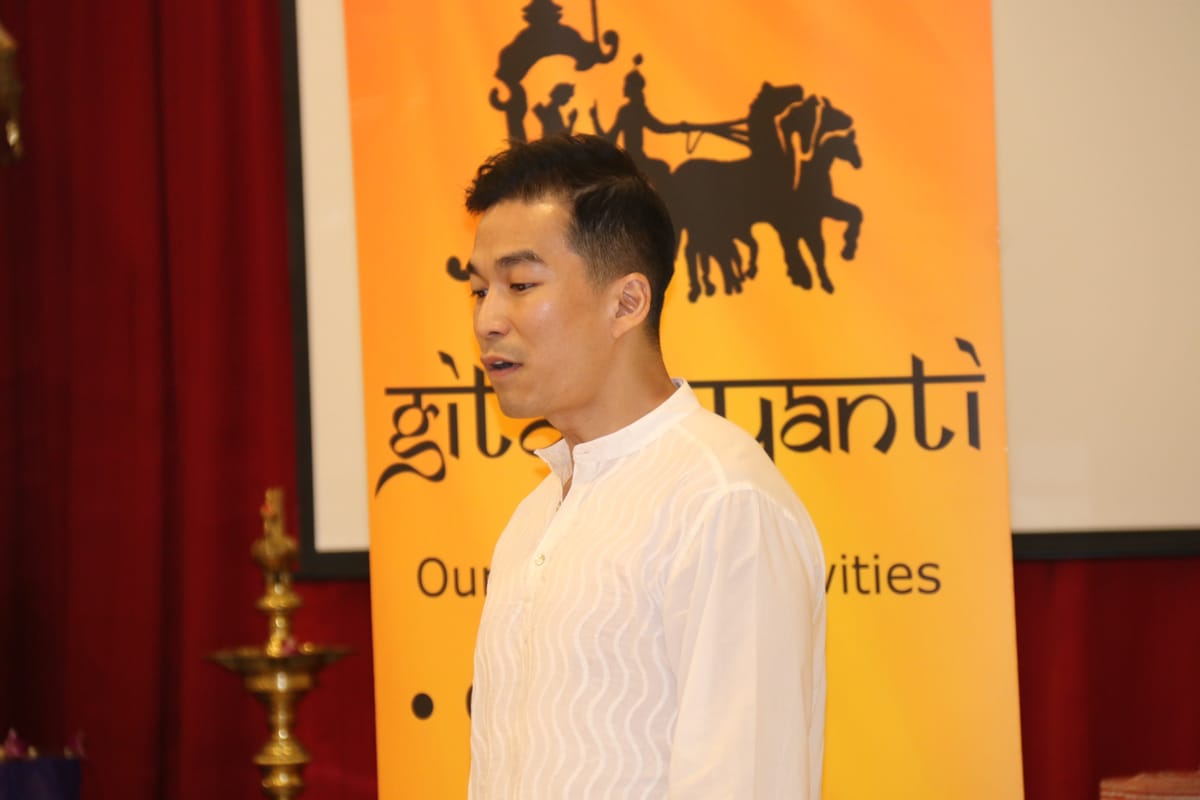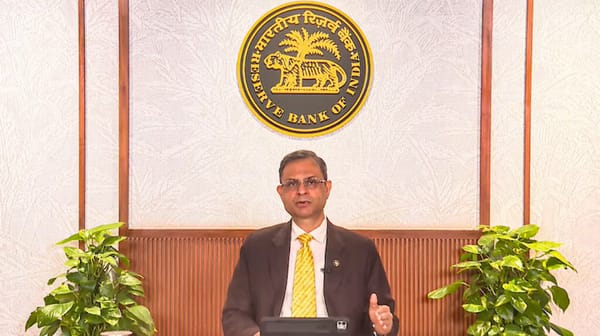A Chinese takes to Chanting!!!

He came, he chanted, he conquered! He conquered the hearts of the judges and the listeners alike.
A sense of sincerity of approach and dedication was evident. Learning to chant and then to present it without mistakes, that too a whole chapter and that too for a competition is no ordinary feat. This feat was considered outstanding because this was accomplished by a Chinese Singaporean with no connection to Hinduism or to the Hindu scriptures or with any Hindu or Indian lineage except his genuine interest to learn the Bhagavad Gita.
Mr Andrew Ong or Kah Woon Ong, 40 years, is a third generation Chinese Singaporean with a postgraduate degree in Economics, presently working as Market Research Director.
Andrew got interested in chanting five years back when he was presented the English translation of the Bhagavad Gita by a friend. He read it closely and was soon deeply interested not only in the content, its relevance but also in the meter, rhyme and rhythm which continues to intrigue him.
In the history of Gita Chanting competitions in Singapore, which is held every year, happening since last 15 years or more, he is the first Chinese to have participated.
For Mrs Padmini Chandrashekar, his Guru, who has been teaching Chanting in Singapore for the last 14 years, Andrew is her first and only Chinese student.
About him, she relates with pride, “He goes deep into each and every syllable while learning to chant. He enjoys the rhythm in the chanting, and takes the initiative to study the meaning of the Gita verses. While in skype class, he would often pick some verses and remark with joy that he enjoyed chanting those specific verses!
If I correct him about a single word in a verse, he would listen carefully and repeat the verse again striving for complete perfection.”
In conversation with Andrew:
How did your interest in Chanting start?
The interest started 5 years ago when I was given an English translation of the Bhagavad Gita - translated by Stephen Mitchell - by a dear friend from Hong Kong. He is a senior teacher from the Art of Living Foundation. I read the entire book within 2 hours; it was captivating and deeply moving.
And strangely enough, I find the Gita to be scientific in its approach to mind management.
A year later, an Indian friend, who is an English teacher from CHIJ School, gave me a copy of “Bhagavad Gita As It Is” by Swami Prabhupada; this book is my first introduction to Sanskrit transliteration with verse by verse commentary of the Gita.
At what age did this interest start?
Looking back, it was through close reading of Swami Prabhupada’s commentary that has developed my interest in Sanskrit chanting.
Through the transliteration, and out of curiosity, I have discovered that each verse is divided into 4 quarters, and in each quarter there are either 8 or 11 syllables, forming either 32 syllables or 44 syllables in total. Little did I know that each verse is composed accordingly to specific rhythmic meters.
I will never forget the moment when I finally realised that every Sanskrit word, in every quarter, in every verse and in every chapter are divided “neatly” according to the rhythmic meters! The Gita is a highly polished Sanskrit composition.
I was 38 when I finally took the courage to learn chanting, and to search for a Guru in chanting.
What draws you to this Chanting?
The sound of Sanskrit is simply beautiful. Since the Gita is composed in rhythmic meters, and the Gita is a song, and hence logically speaking, it can be chanted or sung!
What is it that you particularly like about Chanting?
It is a deep admiration of both the scientific and artistic components of chanting.
The pronunciation of Sanskrit is scientific in nature; the consonants, vowels and 5 areas of voice “placements” are marked out very clearly and precisely.
Furthermore, the “timing” of chanting is also determined by the length of sound of each vowel. It is almost like a “built-in” sound mechanism; so that the Sanskrit sounds can be produced with great precision after so many thousands of years. The artistic component is the warmth of the human voice!
Everyone has a unique voice, but we chant the same sounds as composed in the Gita.
Have you read the Bhagwad Gita and understood its contents and relevance?
Reading is easy when compared to using the knowledge in daily life.
That is the spiritual path I guess? It took Krishna 18 Chapters to convince Arjuna to fight the war, and not to escape, not to run away from his responsibilities and duties.
I find the Gita to be highly relevant in today’s world – that is to be 100% committed in your actions, and the renunciation of the fruits of actions. By being 100%, the mind is not thinking about the past or worrying about the future.
And finally, not being bound by the outcome of the action, as desire is a one-way ticket to misery.
Are you aware of the other Hindu scriptures and books?
I read the Bhagavad Gita, Ashtavakra Gita, Yoga Vasistha, and selected Upanishads (Kena, Katho etc.). These books are from various publications, some with commentary, and some without. The ancient rishis were expressing the “Absolute Truth” through various viewpoints and schools of thought.
But most importantly, I believe that the rishis were expressing their direct experiences of the truth.
Does your family support you in this?
Both my parents are open-minded, and they find it fascinating that I could chant these Sanskrit verses by heart.
How many hours do you spend to learn this?
For last year’s competition, of 2017, (for Chapter 11), I spent about one year to prepare. It took me 1-2 hours each day to learn the pronunciation and rhythm of the text. This year for Chapter 12, it took me about 2 months.
Who has been your Guru and since when?
I have 3 Gurus in my life.
My mother is my first Guru. Sri Sri Ravi Shankar is my spiritual Guru. And Mrs Chandrashekar from Chinmaya Mission, Singapore is my Guru in Sanskrit chanting. She opened my eyes (and ears) to the beauty of Sanskrit sounds and rhythms.
What made you get in touch with her? Why chose her as your Guru for chanting?
I was searching online for a chanting teacher in Singapore. I came across the Gita Jayanti webpage and found her contact details. I wrote her an email, she replied, and in less than 3 days we started our first lesson.
Interestingly, she taught me Gita Dhyanam before Gita chanting! For one month, she was working on my Sanskrit pronunciation and rhythms.
And isn’t Gita Dhyanam an ode to the glory of Gita? And one month later, we dived straight into chanting Chapter 11 of the Gita, and that was sheer hard work! She didn’t give up on me and I kept going; I kept chanting and she kept polishing. Mrs Chandrashekar is both strict and kind, it’s a lethal combination. I have known her for 2 years now, and till today, I am still intimidated by her, her ears are so sharp! Every sound, every word, every verse has to be perfect. And isn’t Sanskrit a ‘Perfected language’?
How do you learn from her? Do you have regular classes?
All the chanting classes are conducted via Skype, and usually at night after work. For the first year, it was usually once a week. I created my own “version” of Gita chanting sheet – with clear markings on short, long vowels, and syllables – with notes written on it after every class. I was determined to improve over time.
About the Indian culture, what do you particularly like?
I like the spiritual knowledge, the scriptures, and the sheer body of work; on understanding human consciousness. The ancient Indian society is definitely highly evolved.
Any particular verse/ chapter in the Gita you particularly like and Why?
I find Chapter 10 of the Gita deeply moving – that Brahman is not merely a featureless absolute.
It is all this world – “I am everything”.
Or in the beautiful words of the Shvetashvatara Upanishad 4.4:
You are the dark blue butterfly,
You are the green parrot with red eyes.
You are the thundercloud, pregnant with lightning.
You are the seasons, you are the seas. You are without beginning,
present everywhere.
You, from whom all worlds are born.
When did you start taking part in chanting competitions? How fruitful do you find that?
I participated in last year’s competition (Chapter 11); that was my first time chanting in front of the panelists, and it was a nerve-wracking experience.
I was more relaxed this year. I am starting to enjoy the preparation process. The competition builds courage, I think. And one has to be 100% focused when chanting in a competition, my mind is completely silent and there’s nothing but Sanskrit sounds flowing from my mouth. And that, by itself, is meditative.
For his Chanting, Andrew got a standing ovation from the judges not only because he chanted impeccably but also without a single glance into the book though adult competitors had the permission to do so, thus winning him a special prize.
Padmini, his Guru has this to say, “Andrew is a great inspiration to all aspirants who wish to learn the Gita. His dedication is remarkable. I have always felt happy and fulfilled while teaching a committed student like Andrew. He is a living proof of the saying, Where there is a will, there is a way!
He has memorised all the verses of Chapters 11 and 12 of the Gita (75 verses in total). Now he is inspired to learn other Sanskrit stotras in addition to the Gita.
I find that Andrew is a gem among students. I would say that a student like Andrew is truly a blessing from Lord Krishna!”
(The article first appeared in the Gita Vani 2018, an annual publication of Gita Jayanti, Singapore)





